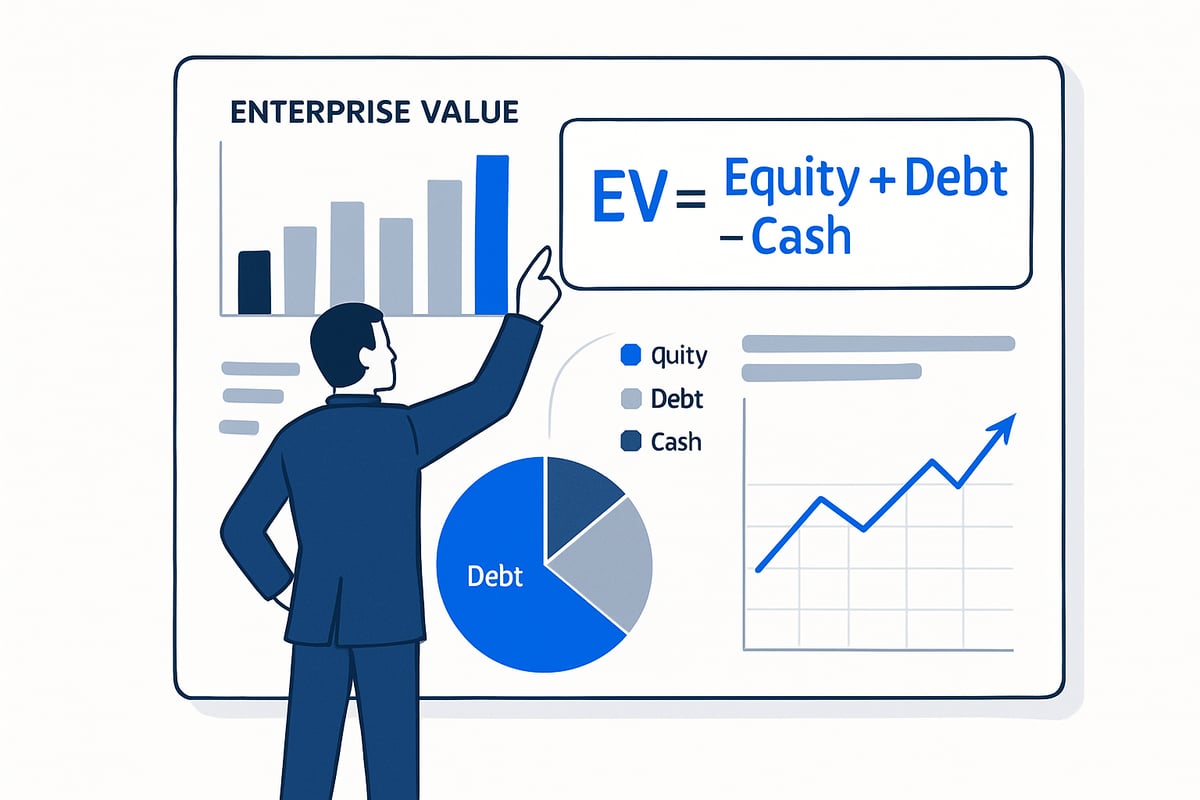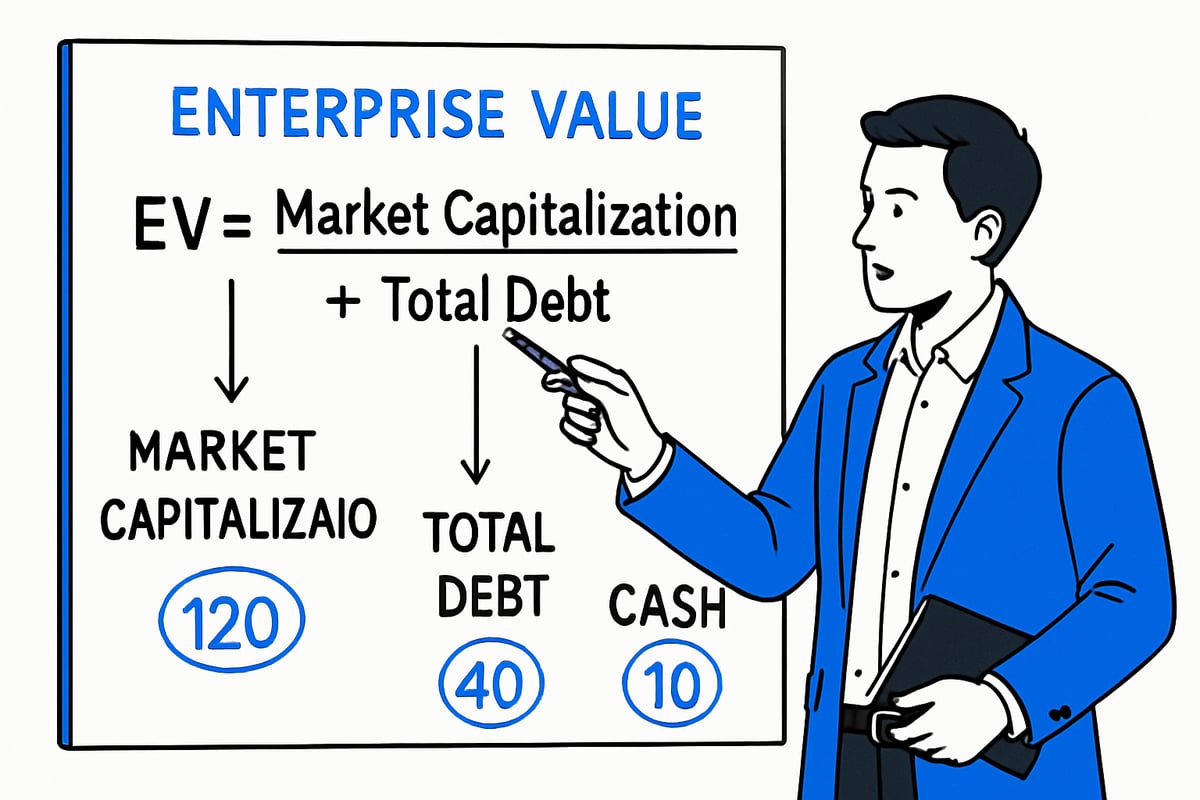Enterprise Value Guide 2025: Strategies for Accurate Business Valuation
In today’s rapidly changing business world, knowing what a company is truly worth is essential for smart decision-making. Yet, traditional methods often miss the mark, leaving leaders and investors searching for a more reliable approach.
This guide puts the spotlight on enterprise value, offering a clear path to understanding and applying this vital metric in 2025. You will discover what enterprise value means, why it matters, how to calculate it accurately, and how to use it for better business outcomes.
Get ready to gain actionable strategies that will help you value companies with confidence and precision.
Understanding Enterprise Value: Definition, Importance, and Core Concepts
Unlocking the true worth of a business starts with understanding enterprise value. This core financial metric provides a holistic snapshot of a company’s total value, considering not just its equity, but also its debts and cash reserves. Let’s break down what enterprise value means, why it matters in 2025, its fundamental components, and how it compares to other valuation metrics.

What is Enterprise Value?
Enterprise value is a comprehensive measure that captures the total value of a company, including both its equity and its debt obligations. Unlike market capitalization, which only reflects the value of a company’s outstanding shares, enterprise value also considers all debt and subtracts cash and cash equivalents. As QuickBooks notes, “EV represents the price to purchase the entire company, including all debt owed.” This makes enterprise value the preferred metric in mergers, acquisitions, and competitive benchmarking, as it shows what a buyer would truly pay to acquire a business. Imagine purchasing a business: you must pay not just for the shares but also assume its debts, while the company’s cash balances reduce your net outlay.
Why Enterprise Value Matters in 2025
In 2025, business structures are more complex and capital sources more diverse than ever. Enterprise value offers a clear lens for investors and executives to assess a company’s overall financial health and strategic position. According to QuickBooks, “EV is key to understanding your company’s overall financial well-being.” By considering debt and cash, enterprise value helps identify undervalued or overvalued companies, supporting better investment and acquisition decisions. For example, Google’s acquisition of YouTube relied on enterprise value calculations to determine a fair purchase price, ensuring all financial obligations and assets were accurately valued.
Key Components of Enterprise Value
Enterprise value is built from three main components:
- Market Capitalization: The total value of a company’s outstanding shares, calculated as share price times shares outstanding.
- Total Debt: All interest-bearing debt, both short and long term.
- Cash and Cash Equivalents: Highly liquid assets that can offset debt.
The formula is:
EV = Market Capitalization + Total Debt – Cash and Cash Equivalents
Each of these elements is sourced from the company’s balance sheet and financial statements. Debt is included because a buyer assumes it in an acquisition, while cash is subtracted since it reduces the effective purchase price. For more on analyzing capital structure in this context, see the Debt-to-equity ratio explained.
Enterprise Value vs. Equity Value
It’s crucial to distinguish between enterprise value and equity value. Equity value, or market capitalization, only measures what shareholders own. Enterprise value includes net debt, offering a more complete picture. Consider the comparison below:
| Metric | Includes Debt? | Subtracts Cash? | Scope |
|---|---|---|---|
| Equity Value | No | No | Shareholders only |
| Enterprise Value | Yes | Yes | Entire company |
As QuickBooks puts it, “Equity value is market cap; EV includes net debt.” Both metrics are important, but enterprise value is favored for its broader perspective in strategic analysis.
When to Use Enterprise Value
Enterprise value is indispensable in scenarios like mergers and acquisitions, investment analysis, and competitive benchmarking. It helps investors and buyers compare companies with different capital structures on a level playing field. However, enterprise value is not always the ideal metric for every industry, particularly those with significant intangible assets or unique financial structures. For example, tech firms with large R&D investments may require adjustments. Despite these caveats, enterprise value remains central to financial ratios and deal structuring, providing a solid foundation for informed business decisions.
Step-by-Step: How to Calculate Enterprise Value Accurately
Accurately determining enterprise value is essential for sound business valuation. This step-by-step guide ensures you gather the right information, apply precise calculations, and avoid common mistakes, leading to reliable results.

Gathering the Right Data
The first step in calculating enterprise value is collecting accurate, up-to-date data. Essential data points include the number of outstanding shares, current share price, total debt, and cash and cash equivalents. Each of these figures can be found in a company’s latest financial statements, such as the balance sheet or annual report.
Precise data is crucial for a trustworthy enterprise value calculation. For example, outdated share counts or missing debt figures can lead to significant errors. If you need to clarify any finance terms during this process, refer to a financial terms glossary to ensure your understanding is complete.
Calculating Market Capitalization
Market capitalization is the foundation of enterprise value. Use the formula:
Market Capitalization = Outstanding Shares × Share Price
Suppose a company has 1 million shares trading at $10 each. Its market capitalization would be $10 million. This figure reflects the market’s perception of the company’s equity value, which can fluctuate daily based on investor sentiment, news, or broader economic changes.
Remember, market capitalization offers a snapshot of what investors are willing to pay for the company’s equity at a specific moment.
Determining Net Debt
To move beyond equity, you need to calculate net debt. The formula is:
Net Debt = Total Debt – Cash – Cash Equivalents
For example, if a company’s total debt stands at $13 million, with $7 million in cash and $2 million in cash equivalents, net debt equals $4 million. Subtracting cash and equivalents is important because these assets reduce the effective cost to acquire the business.
High cash reserves can lower enterprise value, while high debt increases it. Always double-check these numbers from the company’s most recent balance sheet.
Final Enterprise Value Calculation
Now, combine your findings to determine enterprise value. The formula is:
Enterprise Value = Market Capitalization + Net Debt
For instance, with a $10 million market cap and $4 million net debt, enterprise value totals $14 million. This result shows the full cost to acquire the company, factoring in both equity and debt.
Order matters—ensure you first calculate market capitalization, then net debt, and finally sum them. Enterprise value is sensitive to short-term market changes, so timely data is essential for accuracy. Regularly updating your calculations helps you maintain a reliable valuation.
Adjustments for Complex Capital Structures
Some companies have more intricate financial frameworks, which require additional adjustments. These may include convertible bonds, minority interests, preferred stock, or off-balance-sheet liabilities.
When calculating enterprise value for such organizations, add the value of these elements to your formula. For example, conglomerates often carry minority interests or preferred shares that must be included. Transparency is vital, so document each adjustment and its source for future reference.
Common Pitfalls and How to Avoid Them
Several common errors can distort enterprise value calculations. Double-counting debt or ignoring cash equivalents are frequent mistakes. Using outdated share counts or missing new debt issuances can also throw off your results.
Market volatility can affect both share price and debt levels, so always use the latest data. Cross-check your calculations and update your information regularly. These practices help prevent costly miscalculations, ensuring your enterprise value analysis remains robust and dependable.
Enterprise Value in Action: Use Cases, Ratios, and Decision-Making
Understanding how enterprise value works in the real world is crucial for business leaders and investors. This section explores practical applications, essential ratios, and common decision-making scenarios where enterprise value leads the way.

EV-Based Financial Ratios and Their Interpretation
Enterprise value is most powerful when paired with financial ratios that reveal a company's true operational performance. Common ratios include EV/EBITDA, EV/Sales, and EV/Free Cash Flow. Each ratio offers unique insight into valuation.
| Ratio | Formula | What It Shows | Industry Benchmark |
|---|---|---|---|
| EV/EBITDA | EV / EBITDA | Operational efficiency | 10 or lower is ideal |
| EV/Sales | EV / Sales | Revenue valuation | 1–3 is a good range |
| EV/FCF | EV / Free Cash Flow | Cash flow strength | Varies by sector |
For a deeper dive into how these ratios work and why they matter, see Key Financial Ratios Explained. Interpreting enterprise value ratios correctly helps compare companies across industries and identify both risks and opportunities.
Real-World Applications: Mergers, Acquisitions, and LBOs
Enterprise value is foundational during mergers, acquisitions, and leveraged buyouts (LBOs). Buyers use enterprise value to determine the total price required to acquire both equity and debt. This approach ensures the deal reflects the company's full capital structure.
For example, in an LBO, the acquiring firm calculates how much debt financing is needed by referencing enterprise value. High-profile acquisitions, such as Google's purchase of YouTube, relied on accurate enterprise value calculations to set fair purchase prices and structure the deal.
Enterprise value makes it easier to assess feasibility and negotiate terms, ensuring both buyers and sellers are on solid ground.
Benchmarking and Competitive Analysis
Enterprise value is a powerful tool for benchmarking companies of different sizes and capital structures. Investors use enterprise value to evaluate whether a company is undervalued or overvalued compared to its peers.
Suppose a peer group within the same industry shows enterprise value multiples clustered around a certain range. A company with a much lower ratio may be an attractive acquisition target. When comparing enterprise value across a sector, always adjust for industry-specific factors like intangible assets or regulatory capital.
By focusing on enterprise value, investors can spot trends, outliers, and opportunities that might otherwise go unnoticed.
Strategic Planning and Internal Decision-Making
Management teams rely on enterprise value for goal setting and evaluating business units. Enterprise value informs capital allocation decisions, helping leaders prioritize investments, expansions, or divestitures.
For example, a company might use enterprise value to justify expanding into a new market or spinning off a less profitable division. Enterprise value also supports resource prioritization, ensuring capital goes where it will generate the most value.
By integrating enterprise value into strategic planning, organizations gain a holistic view of their financial health and can make informed, data-driven decisions.
Limitations and Caveats in Real-World Use
While enterprise value is a robust metric, it has its limitations. Market assumptions and short-term volatility can distort results. Enterprise value also excludes qualitative factors like brand strength or management quality.
In industries driven by intellectual property, enterprise value may not capture the full picture. Complementary metrics such as DCF or P/E ratio are often needed for thorough analysis.
Key limitations of enterprise value include:
- Sensitivity to market swings
- Exclusion of qualitative data
- Not always suitable for IP-heavy sectors
- Reliance on up-to-date financials
Being aware of these factors is essential for accurate enterprise value analysis.
Frequently Asked Questions About Enterprise Value
- Can enterprise value be negative? Yes, if cash exceeds market cap plus debt.
- What is a good EV/EBITDA ratio? Typically, 10 or lower is considered attractive.
- Why use EV/Sales over EV/EBITDA? EV/Sales focuses on revenue growth, while EV/EBITDA highlights profitability.
- What is the 80% rule for enterprise value? It refers to focusing on the assets that drive most of the company's value.
- When should enterprise value be used? Primarily in M&A, investment analysis, and benchmarking.
Understanding these FAQs helps clarify the practical use of enterprise value in everyday business scenarios.
Advanced Strategies for Accurate Business Valuation in 2025
Modern enterprise value analysis in 2025 goes far beyond traditional calculations. Today, advanced strategies are essential for business leaders who want to stay ahead. Let us explore the most effective approaches for accurate enterprise value measurement in a rapidly changing environment.

Incorporating Forward-Looking Metrics
Relying solely on historical numbers can limit the accuracy of enterprise value calculations. In 2025, integrating forward-looking metrics such as projected EBITDA, anticipated sales, and estimated free cash flows is crucial.
By using forecasts, analysts can better capture future growth potential and risks. For example, adding discounted cash flow (DCF) analysis allows you to estimate terminal value based on future performance. However, it is important to balance optimism with realistic assumptions, as overestimating growth can distort enterprise value outcomes.
Adjusting for Market Volatility and Economic Cycles
Enterprise value is sensitive to market swings. Sudden changes in share price or debt levels can impact valuations significantly. In turbulent years, consider smoothing techniques such as averaging share prices or debt over several quarters.
Scenario analysis can help test how enterprise value responds to different market conditions. This approach prepares businesses for economic cycles, ensuring valuations remain robust. Always review data frequently to reflect the most accurate market environment.
Integrating Industry-Specific Factors
Every industry has unique capital structures and valuation challenges. For instance, tech companies may have significant deferred revenue, while real estate firms rely on tangible assets. Adjusting enterprise value calculations to reflect these differences is essential.
Incorporate sector benchmarks and ratios for greater precision. Tools like Financial Ratios by Industry offer insight into which metrics matter most for your sector. Industry-specific adjustments help ensure enterprise value remains relevant and actionable.
Leveraging Technology and Financial Tools
Technology is transforming enterprise value analysis. Financial software now enables real-time tracking, scenario planning, and automated error-checking. AI-driven platforms can monitor enterprise value continuously, flagging anomalies and suggesting adjustments.
These tools reduce manual mistakes and speed up reporting. By adopting advanced analytics, companies gain a clearer, up-to-date picture of their enterprise value, supporting better decision-making.
Combining EV with Other Valuation Methods
No single metric tells the whole story. Combining enterprise value with other approaches, such as comparable company analysis, precedent transactions, and DCF, provides a more comprehensive view.
For example, use enterprise value as a cross-check against DCF outcomes during merger negotiations. A multi-metric strategy helps identify inconsistencies and strengthens confidence in the final business valuation.
Staying Ahead: Trends and Best Practices for 2025
Staying competitive requires embracing new trends in enterprise value analysis. Key developments include ESG integration, AI-powered forecasting, and global market considerations.
Best practices involve regular enterprise value reviews, scenario-based planning, and transparent communication with stakeholders. Leading companies are using these strategies to boost profitability and adapt to evolving business realities.
Overcoming the Limitations of Enterprise Value: Practical Solutions
Accurately assessing enterprise value is vital, yet it is not without its limitations. Recognizing where enterprise value falls short and applying practical solutions can help you make more informed decisions, regardless of your industry or business model.
Recognizing and Addressing Key Limitations
Enterprise value calculations rely on several assumptions and are often influenced by short-term changes in market conditions. This can lead to misleading signals, especially when there is a sudden market event or a significant shift in a company's capital structure.
Common limitations include:
- Dependence on current market data, which can be volatile
- Exclusion of qualitative factors like leadership or brand value
- Sensitivity to changes in debt or equity structure
For example, after a major market downturn, enterprise value may not reflect a company's long-term prospects. Being aware of these issues helps you avoid over-relying on a single metric.
Integrating Qualitative Factors into Valuation
A comprehensive enterprise value assessment should include both quantitative and qualitative elements. Qualitative factors such as management expertise, brand reputation, and competitive advantages can significantly impact a company's true worth.
Frameworks like SWOT analysis and Porter’s Five Forces can help you systematically evaluate these intangible assets. For instance, a company with exceptional leadership or a strong market position may deserve a valuation premium, even if its enterprise value seems average.
Adjusting your interpretation of enterprise value to account for these strengths ensures a more balanced and realistic view.
Using Complementary Metrics and Analysis
No single metric can capture the full picture. Pairing enterprise value with discounted cash flow (DCF), price-to-earnings (P/E), and industry-specific multiples strengthens your analysis. Cross-verifying results helps you spot inconsistencies and improve confidence in your valuation.
For comparative purposes, exploring Enterprise Value to Operating Cash Flow Ratios by sector can highlight industry benchmarks and reveal outliers. Using a mix of metrics allows you to triangulate value, reducing the risk of misjudgment.
Adapting to Industry and Company-Specific Contexts
Enterprise value is not one-size-fits-all. Asset-heavy industries like utilities require different considerations compared to IP-heavy sectors such as technology or biotech. Startups and high-growth firms may show distorted enterprise value due to undeveloped assets or volatile earnings.
To navigate these differences, consult the Industry Ratio Sources Guide for sector-specific benchmarks. Tailoring your approach ensures enterprise value remains meaningful, whether you are evaluating a mature manufacturer or a disruptive tech startup.
Practical Tips for Reliable Enterprise Value Analysis
To maximize the reliability of your enterprise value analysis:
- Keep data sources current and review calculations regularly
- Use scenario analysis to test assumptions and outcomes
- Involve cross-functional teams for diverse perspectives
- Leverage financial tools and automation for accuracy
Regularly reviewing enterprise value helped one company avoid overpaying during an acquisition by catching a sudden change in debt structure. Applying these strategies ensures your valuation remains robust and actionable.
As we’ve explored, understanding enterprise value is essential for making confident decisions in today’s complex financial world. With Historic Financial News, you gain the unique advantage of exploring market stories through a historical lens—helping you spot patterns, avoid common valuation pitfalls, and learn from the past. If you’re eager to deepen your insights and shape the future of financial analysis, I invite you to Join Our Beta. Together, we can redefine how business value is understood—by looking at the bigger picture and learning from the events that shaped today’s markets.
